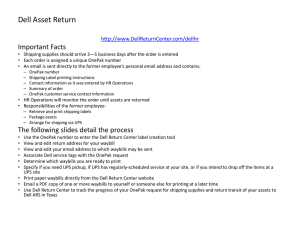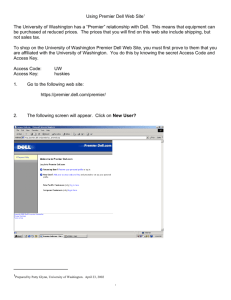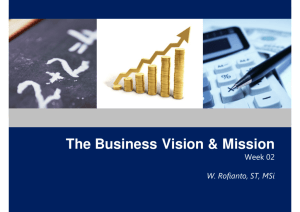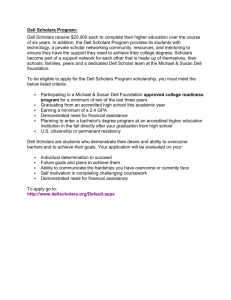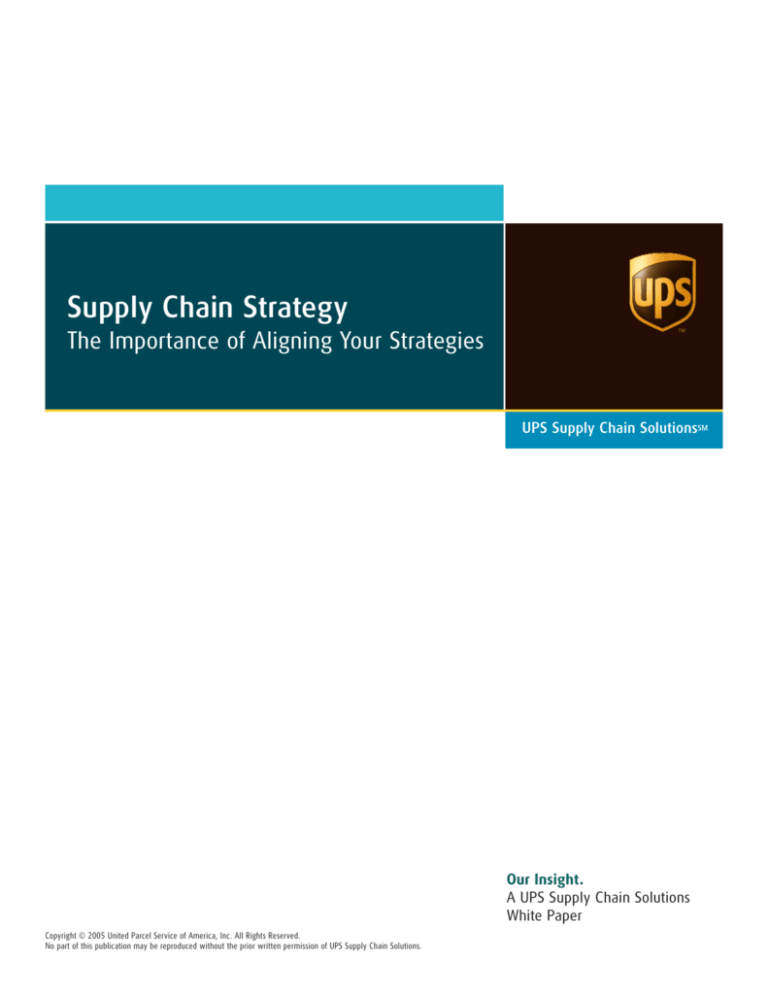
Supply Chain Strategy
The Importance of Aligning Your Strategies
UPS Supply Chain SolutionsSM
Our Insight.
A UPS Supply Chain Solutions
White Paper
Copyright © 2005 United Parcel Service of America, Inc. All Rights Reserved.
No part of this publication may be reproduced without the prior written permission of UPS Supply Chain Solutions.
Introduction
Chances are you’ve heard the term supply chain strategy. Used informally, it is
often confused with supply chain management, where supply chain operations are
controlled to reduce costs. There’s some truth to this definition, but supply chain
strategy really is broader; it defines how the supply chain should operate in order
to compete. Supply chain strategy is an iterative process that evaluates the costbenefit trade-offs of operational components.
A well executed supply chain
strategy results in value
creation for the organization.
Business strategy involves leveraging the core competencies of the organization
to achieve a defined high-level goal or objective. It also includes the analytic and
decision-making process surrounding what to offer (e.g., products and services),
when to offer (timing, business cycles, etc), and where to offer (e.g., markets and
segments) as a competitive plan.
While the business strategy constitutes the overall direction that an
organization wishes to go, the supply chain strategy constitutes the actual
operations of that organization and the extended supply chain to meet a
specific supply chain objective.
That being said, most companies have a business strategy, but are unlikely to
have overtly designed a supply chain strategy. So, why is a supply chain strategy
so important? Well, one good reason is to operationalize and support your
business strategy. At some point, a business strategy must be executed and
typically this is done through the operational components of a company. Supply
chain strategy also focuses on driving down operational costs and maximizing
efficiencies. For example, an organization may choose a strategy directed at
supplier management as a way to remain competitive. By providing
a clear purpose, the organization keeps sight of the strategy and is able to devise
tactical steps to achieve these goals. Another reason for having a supply chain
strategy is to establish how you work with your supply chain partners, including
suppliers, distributors, customers, and even your customers’ customers. As the
marketplace becomes more competitive, it is critical to reinforce existing
relationships and work together. And for all these reasons, a well executed
supply chain strategy results in value creation for the organization.
Developing a Supply Chain Strategy
Understand the Business Strategy
The first step is for supply chain executives to clearly understand how the
enterprise chooses to compete. This is important not only for the obvious reason
of working off the “same play book,” but also for the reason that it forces the
supply chain operation to see itself as a customer facing entity serving the
competitive goals of the enterprise—not merely an operational department.
Supply chain strategy is not simply a linear derivative of the business strategy.
At best, supply chain strategy can be the enabler of the business strategy. If the
business strategy is to be the low cost provider, the supply chain strategy should
support this. And just like when developing a business strategy, look to your core
competencies, focus, and means of differentiation when developing a supply chain
strategy. Being able to strategically source parts at an attractive price may support
UPS Supply Chain Solutions
1
both your supply chain strategy and business strategy, but only if you have the
capabilities to do so effectively. Look to your supply chain competencies and
leverage what you do well. You may want to focus on a particular market or
segment in which to gain supply chain efficiencies. Or you may want to
differentiate your organization operationally by providing lower costs to
customers or providing services that other industry players are unable to do.
Assess the Extended Supply Chain
A formal supply chain
assessment by a non-biased
outside party may assist
you in better understanding
your...opportunities for
improvement.
The next step is to conduct a detailed, realistic assessment of the capabilities that
exist within the organization and even the extended supply chain. Begin by closely
scrutinizing your organization’s assets and evaluate how well they support the
strategy. Old machinery and disparate systems may mean high operational
overhead and costly process inefficiencies and redundancies – clearly not
supportive of a low cost provider strategy. A formal supply chain assessment by a
non-biased outside party may assist you in better understanding your operational
strengths and opportunities for improvement. Look for a firm that can provide
you with operational benchmarks both inside and outside of your industry in
order to gauge core competencies. Once the assessment is complete, assemble a
team to review and prioritize recommendations, validate the opportunities, define
the risks, and the requirements for implementation. Ultimately, if there is a
disparity between the supply chain strategy and the operational assets, you may
have to make capital investments. Of course, the other alternative is to change
your assumptions and alter your strategy all together!
Develop an Implementation Plan
From this critical work emerges the “go forward” supply chain strategy – directly
tied to the business strategy, highly specific as to enablers and metrics, and with a
defined set of implementation requirements and contingencies. The development
of an implementation plan should include activities and tasks, roles,
responsibilities, a corresponding timeline, and performance metrics. Establish a
sub-team to shepherd the execution and provide project management
responsibility to resolve issues and track status.
Development Considerations
Cooperate and Collaborate with Your Partners – Throughout the development
process remember to include your supply chain partners. While you don’t necessary
need to divulge the full details of your strategy, you can certainly communicate how
you would like to do business. Ideally, seek out mutual goals that both
organizations can execute on. Not only will you be one step closer to realizing your
supply chain strategy, you will learn more about the companies that you do
business with. For example, collaboration in product design may meet your need to
stem R&D costs and also alert you to new product concepts that you wouldn’t
discover without working with your customer.
Outsource Where Appropriate – Part of developing a supply chain strategy includes
evaluating opportunities to outsource areas that are not your core competency. If
someone else can do it cheaper, it may be worth outsourcing not only to drive down
costs, but also to focus more resources on the core competencies your
organization does well.
UPS Supply Chain Solutions
2
Case in Point: Inamed
Rising from humble beginnings, Inamed, a leading medical device
company, has seen itself grow to become a $300 million dollar
company with its stock value increasing almost 200% over the last
year. The company is credited with a clear business strategy of
growth through acquisition and new product innovations. Anticipating
continued growth and business success, Inamed needed a supply
chain strategy consistent with an expanding organization.
Faced with such challenging supply chain questions as “what is our
optimal distribution network?”; “should we outsource some supply
chain activities?” and “how can costs be better managed and
contained?” the company conducted a global supply chain
assessment to identify supply chain costs and opportunities.
In addition to offering supply chain strategy recommendations, the
study provided a total picture of Inamed’s supply chain costs and
compared them to industry and non-industry benchmarks. Over $4
million in process improvements and cost saving opportunities were
identified. Now armed with a supply chain strategy, Inamed is in the
process of implementing these changes.
Executing Supply Chain Strategy
Performance Management
REWARDS AND REPORTING
Performance management
works best when people are
rewarded for their performance
and reporting is conducted on
a regular basis.
Execution involves closely following your implementation plan and applying good
project governance. You can improve your chances for success by managing
performance throughout implementation and beyond. Tracking performance
allows an organization to measure how successful it is in realizing the goals of a
strategy. It also makes people understand their contribution and responsibilities,
creating a more cohesive, in tune, organization. Performance management works
best when people are rewarded for their performance and reporting is conducted
on a regular basis. Moreover, performance goals should be used to communicate
business expectations to outside entities as well. The more the extended supply
chain is involved, the more the supply chain strategy is supported and reinforced.
Iterate the Cost – Benefit Evaluation Process
On a periodic basis (e.g., annually) you should formally revisit your supply chain
strategy. Did you meet the goals of the business strategy? Have the needs of your
supply chain partners changed? How has the industry changed i.e., new
competitors, business practices, products, technology? At this time, you may even
want to reassess your supply chain organization, if the changes are significant
enough to warrant it. Also, use this effort to look for new opportunities to further
position your organization for success.
Good communications can
keep the extended supply
chain in sync.
Keep Communicating with Your Partners
Executing a supply chain strategy means dealing with many different entities,
both internally and externally. Just as it is crucial to align the supply chain
strategy with the business strategy, it is equally important to execute in a manner
consistent with these different groups or stakeholders. The goals of your supply
chain components and those that you deal with must be similar and conducted at
the same speed. Your organization may be able to move at speeds other supply
chain entities are unable to maintain, resulting in misalignment and poor
efficiencies. And some of your supply chain partners may not have the resources
to commit to realizing these goals. Good communication can keep the extended
supply chain in sync.
UPS Supply Chain Solutions
3
Avoiding Potential Pitfalls
Even before the well-publicized dot com collapes, business failures due to poorly
implemented strategy were very frequent. Fortune Magazine reported in a study
that CEO strategy failures occurred primarily (est. 70%) because of failure in
execution, not with the vision and strategy development. “The real problem isn’t
the high-concept boners the boffins love to talk about. It’s bad execution. As
simple as that: not getting things done, being indecisive, not delivering on
commitments.”1 And supply chain strategy is no different! During the build &
implement phases, there are additional challenges including:
Align the Supply Chain Strategy with the Business Strategy
Most companies develop a supply chain strategy after the business strategy has
been defined. While this approach can deliver some value, it does not support the
infusion into the business strategy development of very powerful supply chain
model options, which could significantly improve the business strategy.
A supply chain strategy should always support the intent of the business strategy
Case in Point: Dell
Dell broke into the big time by developing a business strategy and
supply chain strategy that worked together. In the late 1980’s and
early 1990’s Dell’s business strategy was differentiation through low
cost, speed of delivery, and customer service. The major channel for
sales was from customers to call centers. However, the emergence of
the internet called for more differentiation and fundamental change.
With a well understood business strategy, Dell began to formally
integrate operational components (e.g., logistics, manufacturing,
distribution, inventory management) and develop a supply chain
strategy. The supply chain strategy focused at driving costs out of the
supply chain – being the low cost provider – while at the same time
supporting a business strategy emphasizing customer service.
processing orders direct from customers, building the computers to a
customers specification, and delivery within a matter of days. To
support this model, Dell asked suppliers to keep inventories within
15 minutes of the manufacturing locations. Virtually all products are
made to order. “Every two hours, the factory planning system sends
out a computerized message to suppliers detailing what parts the
plant needs. That means there is almost no inventory of parts or
products in the factory.”2 Besides excellent working capital
advantages, Dell also sells computers that are about two months
newer than the competition! In an industry where component prices
fall about 20% per year, this means significant cost-of-goods-sold
advantages for Dell.
How was Dell successful with such conflicting charters?
The Future of Dell
Internally, Business Performance Contracts (BPCs) were crafted that
defined formal, but flexible operational agreements between each
operational process area. These contracts tied to individual
performance targets so that imperatives were clear. Execution
concentrated on four areas: collaboration, value engineering,
outsourcing, and the Out-of-Box Experience (OBE). As part of the
process, the BPCs were also shared with the extended supply chain
and similar operating agreements were arranged. These processes
effectively kept the organization’s focus on strategy through
performance management.
Dell has continued to refine its business strategy, most recently by
entering new markets such as printers and electronics in order to
grow revenue. The company has set aggressive revenue targets –
$60 billion by 2006 – almost double the earned revenue today. To
meet these goals and the changing business environment, the
company proactively reevaluates its supply chain strategy. This is
not only to make sure that the supply chain is strategy aligned with
the business strategy, but also to keep ahead of the competition.
According to CEO Rollins, Dell “manages the value chain better
than anyone else on the planet; the only one who might come
close to us might be Wal-Mart.”3
Externally, Dell worked with suppliers to help control costs and
improve customer service. Dell’s retail direct strategy requires
1
“Why CEO’s Fail,” Fortune Magazine, June 21, 1999.
2
“Dell: One Company, Two CEO’s,” CEO Magazine, November 2003, pg. 34.
3
Ibid.
UPS Supply Chain Solutions
4
and it is precisely because of these different “levels” of the enterprise at which
strategies necessarily must be developed, that companies so often have major gaps
between their highest level business strategy and their supply chain strategy. There
are some additional risks associated with developing these separately, which
include:
The need to think strategically
about the supply chain has
never been more important.
• Developing a supply chain strategy without a true understanding of the
business case and value propositions – the costs and benefits are not known
• Utilizing different or new resources in the operational model development that
weren’t exposed to the original business strategy thinking, thereby diluting and
weakening the supply chain strategy
• Confusing or conflicting communications to the organization where objectives
may be contradictory
Organization Challenges
The company and its organizational culture play a key role in developing and
executing a supply chain strategy. The following are some common organizational
challenges found in many companies:
Lack of ownership – many supply chain processes and value levers do not have
an owner in the traditional sense
“Tower of Babel” problem – most organizations across the enterprise do not
speak a common supply chain language
Organizational focus – some managers are functional or process oriented and
do not understand the value levers’ multiple drivers model
Extending the Supply Chain – most supply chain initiatives involve external
parties (trading partners) which makes strong collaboration a requirement
Conclusion
As supply chains have moved from a cost focus to a customer focus and now
currently to a strategic focus, the need to think strategically about the supply
chain has never been more important. The success of a strategy is only as good
as the company’s ability to fully and properly execute it. A great supply chain
strategy, linked with operational excellence, can provide success for not only the
company in question but also its partners and customers.
UPS Supply Chain Solutions
5
About the Author
Susan Happek is a principal at UPS Supply Chain Solutions. Susan is based in
Atlanta, GA and can be reached at shappek@ups-scs.com.
To learn more about how our experience in supply chains and consulting can
benefit your business, please contact us:
1.800.742.5727 U.S.
678.746.4365 International
Visit us at ups-scs.com
About UPS Supply Chain Solutions
By aligning a client’s business strategies with its operating processes, UPS
Supply Chain Solutions can create high-performance supply chains that from
inception to implementation generate real, hard-number values and quick
benefit realization. This distinguishing capability, our experience in solving
real-world challenges, and the resources of UPS enable us to set strategies,
design and build solutions as well as implement, operate, manage and
synchronize your world of commerce.
Copyright © 2005 United Parcel Service of America, Inc. All Rights Reserved. WP.SCS.CS.638
No part of this publication may be reproduced without the prior written permission of UPS Supply Chain Solutions.
UPS Supply Chain Solutions
6



